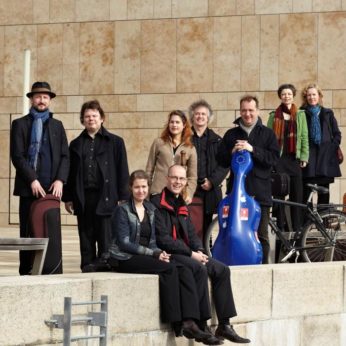Composer: Johann Sebastian Bach (b. 1685 - d. 1750)
Performance date: 03/07/2016
Venue: St. Brendan’s Church
Composition Year: 1727
Duration: 00:13:33
Recording Engineer: Richard McCullough, RTÉ lyric fm
Instrumentation: 2vn, 2va, 2vc
Instrumentation Category:Baroque Ensemble
Instrumentation Other: S-solo, ob, 3vn, va, 2vc, rec, db, lute, hpd
Artists:
Concerto Copenhagen (Antoine Toruncyzk [oboe], Fredrik From, Peter Spissky, Antina Hugosson [violins], Torbjörn Köhl [viola], Judith-Maria Blomsterberg [cello], Kate Hearne [cello, recorder], Marrias Frostenson [bass], Fredrik Bock [theorbo], Marcus Mohlin [harpsichord]) -
[baroque ensemble]
Carolyn Sampson -
[soprano]

Ich bin vergnügt mit meinem Glücke, BWV 84 (I am content in my good fortune) was
composed in Leipzig in 1727 for Septuagesima Sunday and is unusual in that it a
solo cantata. BWV 84 belongs to a group of twelve solo cantatas Bach composed
after the summer of 1726. The 209 surviving cantatas of Johann Sebastian Bach
are some of his most notable compositions, the earliest surviving cantata dates
from 1707 and the last is thought to have been written in 1745. Most of Bach’s
cantatas date from his early years as the cantor in Leipzig where he was
required to perform a church cantata for every Sunday and Holiday.
It is unknown who
wrote the text for this particular cantata but the libretto bears a striking
resemblance to that of the cantata Ich
bin vergnügt mit meinem Stande (I am content with my position), published
by Bach’s lyricist Picander in 1728. The
text is related to the gospel and differs from many other cantatas in its
absence of sadness, upset, fear of death, atonement and sense of sin. BWV 84
rather focuses on the moralistic call of the Christian to live a virtuous and
austere life in gratitude to God. The
language is straightforward, succinct and sagacious which was unusual in an era
of figurative rhetoric.
The work is
structured in five movements, alternating between arias and recitatives and
finally a closing chorale, the text of which is taken from the twelfth stanza
of the funeral hymn Wer weiß, wie nahe mir
mein Ende by Ämilie
Juliane von Schwarzburg-Rudolstadt
and sung to the tune of Neumarks Wer nur
den lieben Gott last Walten.
The opening aria is
in E minor with a slow and quiet swaying rhythm reminiscent of French
overtures. The oboe and soprano are pulled in wandering, decorative wistful
lines over a chordal string accompaniment. The following recitative is
extensive and austere with a plain vocal line devoid of any decoration, melisma
or arioso passages. The second aria brings a completely different character,
the words Freude and fröhlich reflect the carefree music in G
major. The aria has a folk dancing feel to it; the oboe becomes the rustic
chanter over the ongoing open strings of the violin that suggest the drones of
bagpipes or a honky-tonk. In the second recitative the significance of the
soprano’s text is given additional authority by a solemn string accompaniment.
The final Chorale, as already mentioned takes it’s text from a funeral hymn and
displays four-part harmonization in a remarkably simple, sparse and austere
style for the composer.
Copyright © 2025 West Cork Music. All rights reserved.
Designed and developed by Matrix Internet